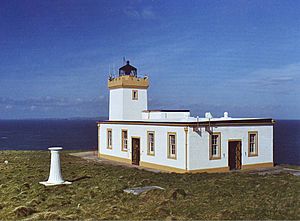Duncansby Head facts for kids
 |
|
| Duncansby Head Lighthouse | |
| Location | Duncansby Head Scotland United Kingdom |
|---|---|
| Coordinates | 58°38′39″N 3°01′30″W / 58.644039°N 3.025120°W |
| Year first constructed | 1924 |
| Construction | concrete tower |
| Tower shape | square tower with balcony and lantern |
| Markings / pattern | white tower, black lantern, ochre balcony |
| Height | 11 m (36 ft) |
| Focal height | 67 m (220 ft) |
| Intensity | 596,000 cd |
| Range | 22 nmi (41 km) |
| Characteristic | Fl W 12 s |
| Admiralty number | A3558 |
| NGA number | 3016 |
| ARLHS number | SCO-062 |
Duncansby Head (also known as Scottish Gaelic: Ceann Dhunngain or Dùn Gasbaith in Scottish Gaelic) is a famous spot in Scotland. It is the most northeasterly part of the British mainland. You can find it a little northeast of John o' Groats. This special place is located in Caithness, which is part of the Highland region in northern Scotland. The headland, which is a piece of land sticking out into the sea, is surrounded by water. The North Sea is to its east, the Pentland Firth to its north and west, and the Moray Firth to its south. It is a truly wild and beautiful place!
Duncansby Head Lighthouse: A Guiding Light
The point of Duncansby Head is marked by the Duncansby Head Lighthouse. This important lighthouse was built in 1924 by a famous engineer named David Alan Stevenson. Lighthouses are tall towers with bright lights. They help ships find their way safely, especially at night or in bad weather. The light from Duncansby Head Lighthouse can be seen from far away.
Getting There: The Road to Duncansby Head
A small public road leads from John o' Groats directly to Duncansby Head. This makes Duncansby Head the farthest point you can reach by road from Land's End. Land's End is at the very southwestern tip of England. So, driving from Land's End to Duncansby Head is a very long journey across Great Britain!
Nature's Wonders: Duncansby Stacks
The area around Duncansby Head is very special for nature. It is part of a Site of Special Scientific Interest (SSSI). This means it is a protected area because of its unique plants, animals, or geological features. This protected coastal stretch goes for about 6.5 kilometers (4 miles) south to Skirza Head.
One of the most amazing sights here are the Duncansby Stacks. These are tall, pillar-like rocks that stand just off the coast in the sea. They were formed over many, many years by the sea and wind eroding the cliffs. These stacks are a popular spot for photographers and nature lovers.

